Environmental risk analytics platforms are now essential for businesses to manage risks, comply with regulations, and meet investor expectations. Extreme weather events, stricter regulations, and the rise of ESG-focused investments have made these tools indispensable. Here's a look at six leading platforms:
- Workiva: Best for large enterprises needing compliance tools. Features include carbon management, automated reporting, and real-time collaboration.
- Coupa: Focuses on supply chain and sustainability management. Offers tools for emissions tracking, supplier risk assessment, and ESG integration.
- Manifest Climate: Ideal for finance and insurance sectors. Uses AI to automate ESG reporting and assess climate risks.
- Adapt Ready: Excels in geospatial analytics and supply chain risk assessments. Helps industries manage global and local risks.
- EarthScan: Provides high-resolution climate risk assessments for asset management, real estate, and more. Supports compliance with global frameworks.
- RiskPal: Simplifies risk assessments with customizable templates, audit logs, and supplier databases. Popular in education and media sectors.
Why These Platforms Matter
- Businesses with strong ESG practices see 2.6x higher shareholder returns.
- ESG-focused investments are projected to reach $33.9 trillion by 2026.
- 66% of global companies face high risks under climate change scenarios by 2050.
Quick Tip: Choose a platform based on your industry's needs, regulatory requirements, and focus areas like compliance, supply chain, or climate risk modeling.
Turn Environmental Data to Actionable Insights: Explore IBM Environmental Intelligence
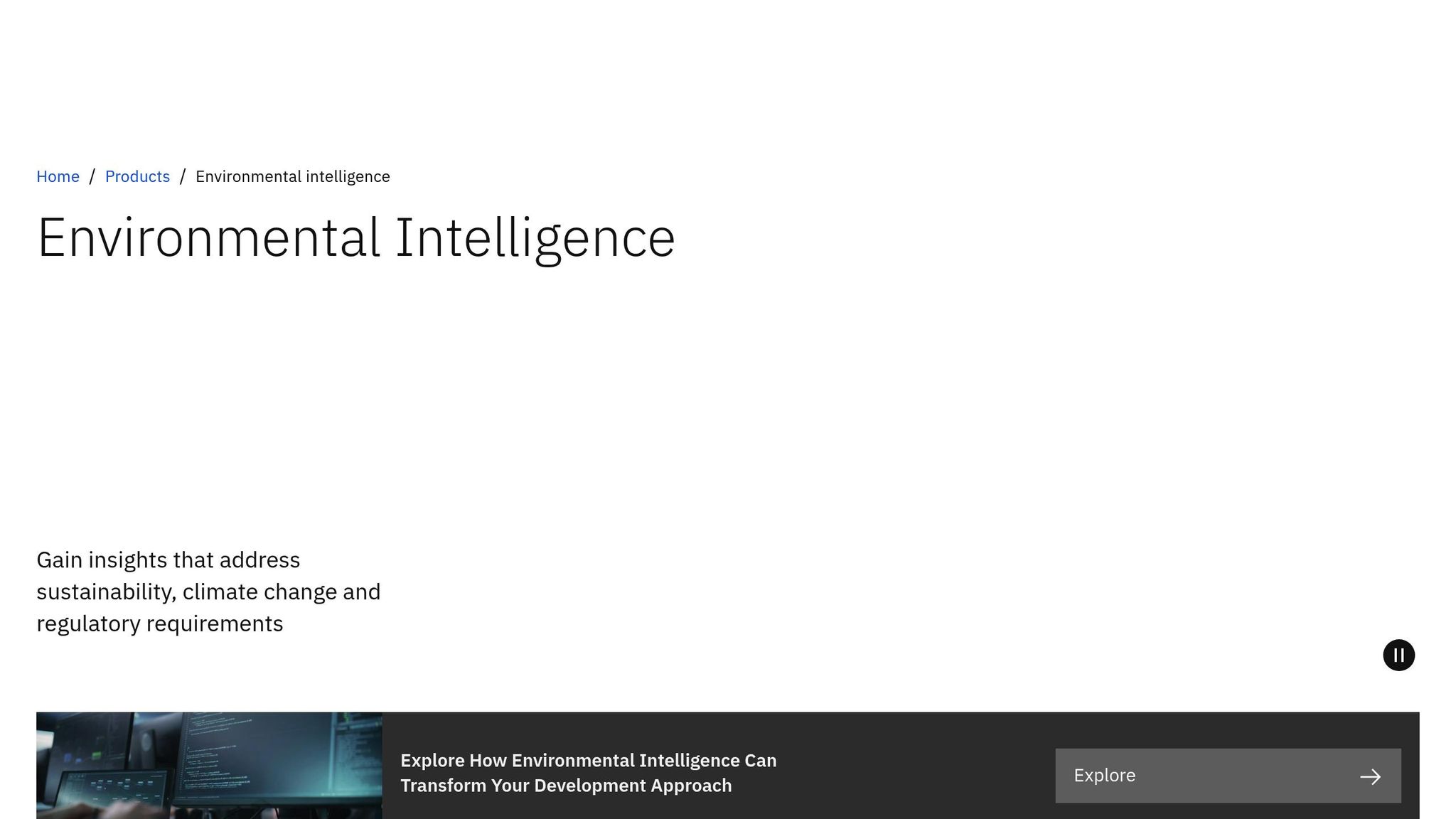
1. Workiva
Workiva is a trusted platform used by over 6,300 organizations worldwide. It has been recognized as a Leader in the 2025 IDC MarketScape for ESG Reporting and Compliance Management Applications and earned an MSCI ESG Rating of AAA in 2024.
Environmental Risk Reporting Capabilities
Workiva’s ESG software simplifies environmental reporting by adhering to rigorous standards, allowing organizations to align their ESG strategies with real-time collaboration and detailed workflows. It identifies risks, validates data through APIs, and automates benchmarks within a connected ESG hub. Teams can collaborate globally with full visibility and manage permissions at a granular level.
One standout feature is Workiva Carbon, which provides tools for carbon accounting, management, and decarbonization across Scope 1, 2, and 3 emissions. This offering became even more robust in June 2024 when Workiva acquired Sustain.Life, a carbon accounting startup, to enhance its sustainability reporting capabilities.
These features are adaptable to industry-specific needs, making sustainability management more targeted and effective.
Industry-Specific Applications
Workiva’s platform is designed to handle diverse industry requirements by integrating multiple data streams, creating a unified approach to sustainability management. This allows companies to evaluate sustainability risks across their supply chain and monitor mitigation efforts efficiently.
For instance, organizations like Great Eastern Life, Santander Brazil, and Diversified Energy have used Workiva’s tools to improve reporting accuracy and reduce manual workloads.
Key Features for Analytics and Compliance
Workiva simplifies ESG reporting with pre-built templates that align with established frameworks, making it easier to meet global standards. Its AI-powered tools enhance team efficiency, improve data insights, and ensure reporting accuracy across sustainability programs.
The platform supports on-demand reporting by linking evidence directly to source documents and capturing audit history in SEC-ready XBRL format, ensuring readiness for regulatory audits. Additionally, it integrates ESG risks into an organization’s Enterprise Risk Management (ERM) program, offering robust controls across the ESG landscape.
Relevance for U.S.-Based Industries
For companies in the U.S., Workiva’s platform aligns seamlessly with domestic regulations and reporting frameworks. It supports compliance with the Sustainability Accounting Standards Board (SASB), Global Reporting Initiative (GRI), United Nations Sustainable Development Goals (UN SDGs), and Task Force on Climate-Related Financial Disclosure (TCFD). Its ability to validate ESG data in SEC-ready XBRL format is particularly useful for publicly traded companies under growing regulatory pressure.
Workiva also addresses state-specific requirements, such as California’s environmental regulations, helping companies navigate local compliance needs. Features like automated data collection, materiality assessments, and structured reporting make ESG compliance easier for U.S. industries.
"Sustainability fuels performance. We believe that by integrating sustainability into our operations, we're not only building long-term value but also managing risk and creating a better future for all." - Workiva
2. Coupa
Coupa's ESG management software helps businesses make smarter spending and supply chain decisions by incorporating sustainability, diversity, and supplier risk into their sourcing strategies. According to Deloitte's 2024 Sustainability Action Report, more than half of businesses now establish ESG teams to enhance resilience.
Environmental Risk Reporting Capabilities
Coupa’s tools model Scope 1, 2, and 3 emissions while managing regulatory risks to ensure compliance. This is especially important as Scope 3 emissions typically account for 75% of a company's total emissions. By embedding sustainability, diversity, and risk data into spending decisions, Coupa allows businesses to integrate ESG requirements directly into their sourcing processes. For instance, Microsoft used Coupa’s Supply Chain Design and Planning tools during a data center expansion. By employing a digital twin to optimize logistics, Microsoft reduced trucking emissions in North America by 60%.
Industry-Specific Applications
Coupa’s platform is versatile, catering to the unique needs of industries like consumer goods and food and beverage. Sahana Subramanian, Sr. Manager of Supply Chain at Coupa, highlights this advantage:
"Supply chain sustainability can be a good selling point, especially for companies in verticals like consumer goods and food and beverage. Procuring materials in the most sustainable way and tailoring your packaging can really set you apart from competitors."
Tetra Pak has integrated ESG criteria into its tendering processes and standardized templates to advance its strategic sourcing. Raul Padilla, Category Manager at Tetra Pak, explains:
"We want to achieve net zero by 2030 in our own operations. Within logistics, we are developing KPIs so we can address them and include them in our tenders so suppliers know they are a criteria for selection."
Similarly, the Bank of Montreal (BMO) implemented Coupa’s digital vetting workflow to evaluate supplier risks before sourcing. This reduced their risk assessment cycle by 75% while improving compliance and operational efficiency.
Key Features for Analytics and Compliance
Coupa provides real-time insights into supplier performance, leveraging $8 trillion in anonymized transactional data. The platform continuously monitors supplier risk scores, ensuring companies work only with pre-vetted suppliers within acceptable risk levels. It also enables businesses to identify and onboard diverse suppliers while analyzing spending patterns. Notably, 60% of senior executives now request ESG data during supplier onboarding.
Beyond monitoring, Coupa uses predictive models and market trends to help companies prepare for supply chain disruptions. Integrations like the EcoVadis Coupa Connector, available through Coupa's App Marketplace, simplify incorporating third-party sustainability assessments into procurement decisions.
Relevance for U.S.-Based Industries
For U.S. companies, Coupa delivers the intelligence needed to navigate evolving regulatory requirements. Nigel Pegg, SVP of Platform at Coupa, emphasizes:
"With the need for more intelligence to comply with an ever-evolving regulatory and risk landscape, an authoritative source of truth for sustainability – easily managed at scale– is more critical than ever."
The platform supports compliance with regulations like California's ESG mandates, which require reporting on greenhouse gas emissions and climate-related financial risks. Coupa helps U.S. businesses establish environmental impact baselines, covering Scope 1, 2, and 3 emissions, energy use, and waste generation. Its digital twin feature allows businesses to model various ESG scenarios, enabling them to stay ahead of consumer demand for sustainable products. Notably, products with ESG-related claims have seen 28% cumulative growth over five years, compared to 20% for those without.
3. Manifest Climate
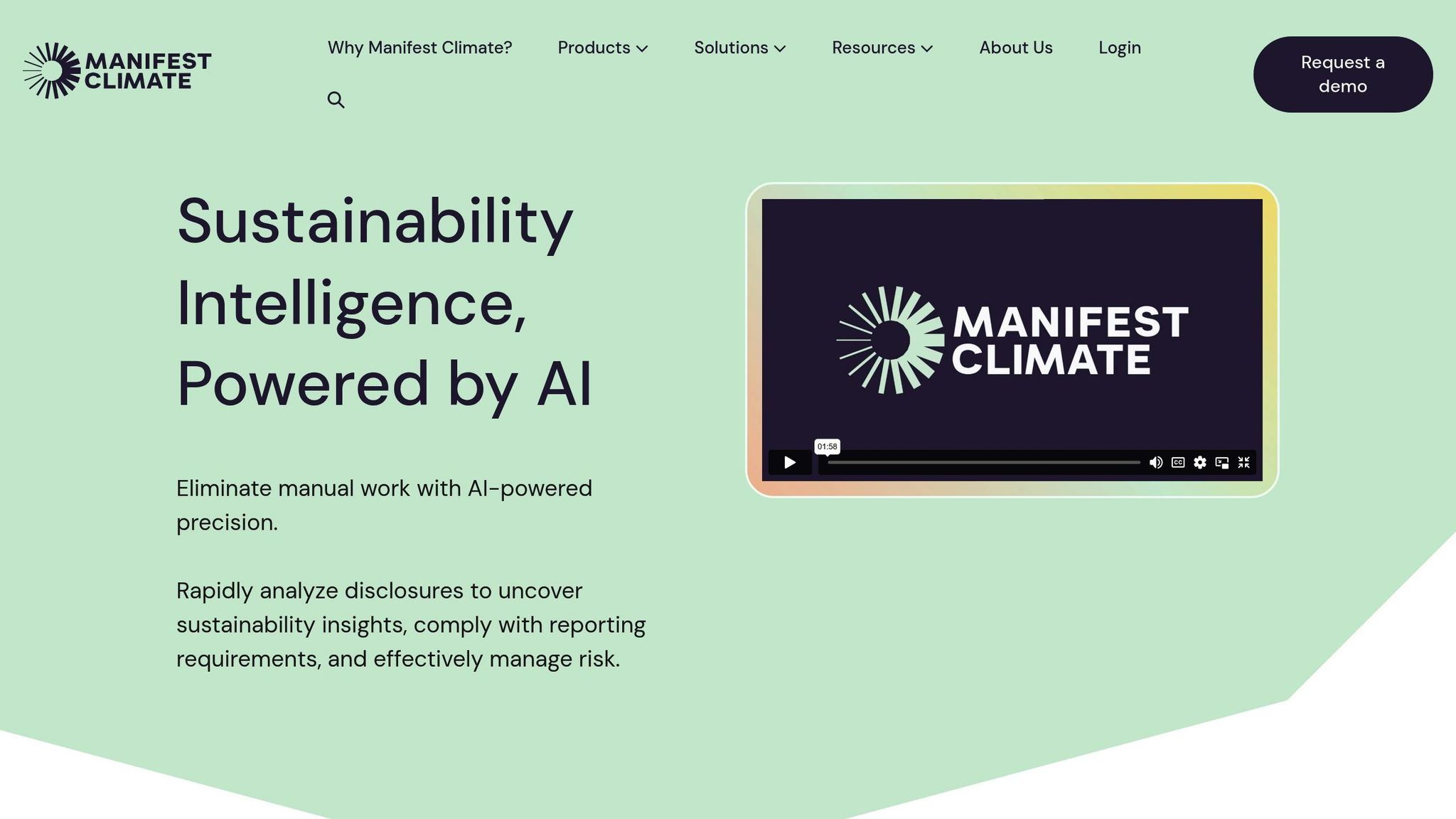
Manifest Climate employs AI to streamline the analysis of environmental risks, achieving 90% first-pass accuracy in ESG (Environmental, Social, and Governance) coverage across global standards.
Environmental Risk Reporting Capabilities
The platform's standout feature is its ability to automate up to 80% of the manual workload involved in ESG reporting. It centralizes ESG data by mapping disclosures to global frameworks, identifying missing information, benchmarking against industry peers, and monitoring regulatory updates. By analyzing a variety of documents - such as ESG reports and public disclosures - Manifest Climate transforms raw data into actionable insights. This efficiency enables organizations to save up to 75% of manual effort and cut costs by as much as 50% in climate-related disclosure processes.
Designed around the TCFD's (Task Force on Climate-Related Financial Disclosures) 11 key recommendations, the software evaluates climate disclosures and management practices against multiple standards.
"Manifest Climate's AI-powered platform enables our team to automate 80% of the long-haul, time-consuming groundwork." - Hannie Fisher, Director of Sustainability and Decarbonization at Civitas Resources
This level of automation allows for seamless adaptation to industry-specific needs.
Industry-Specific Applications
Manifest Climate supports a wide range of industries by offering customizable taxonomies that organizations can tailor to their requirements. For instance, PwC Canada uses the platform to access real-time sustainability data, enabling quicker client service. Sarah Keyes, Partner in Sustainability Strategy & Transformation at PwC Canada, highlights:
"With Manifest Climate, PwC taps into trusted sustainability data and curated expertise in real time. Instead of spending hours researching client disclosures, we can understand exactly what our clients are doing and deliver insights faster, with confidence."
In the food and beverage sector, High Liner Foods relies on the platform to pinpoint compliance gaps. Josh Austin, Senior Manager of Sustainability at High Liner Foods, shares:
"Manifest Climate helps us understand how to comply with relevant climate disclosure frameworks, identify compliance gaps, and build an action plan to be self-reliant."
Consulting firms also benefit, using the tool to identify companies facing ESG challenges and offering tailored solutions. Additionally, South Pole uses it to highlight disclosure gaps for clients, while Gore Mutual maximizes the efficiency of existing resources through the platform.
These examples showcase how Manifest Climate adapts to the specific needs of different sectors while emphasizing its analytical strengths.
Key Features for Analytics and Compliance
The platform includes advanced analytical tools that simplify compliance efforts. With AI-driven gap analysis and real-time intelligence, it evaluates over 1,500 data points to quickly identify and map disclosure gaps. This functionality supports adherence to frameworks like CSRD (Corporate Sustainability Reporting Directive), TCFD, and ISSB (International Sustainability Standards Board). By reducing manual research time by up to 99%, teams can focus more on strategic decisions.
"Manifest Climate gives us more comfort and confidence in the assessment we're making around our gaps, and the robustness of our report." - Chris Adachi, Director of Climate Change at Teck Resources
Relevance for U.S.-Based Industries
For companies in the U.S., Manifest Climate simplifies ESG compliance by breaking down complex regulatory language into clear, actionable KPIs. The platform ensures organizations stay updated on changing regulations while helping establish and monitor progress on key metrics.
In May 2024, SCI, North America's largest funeral and death care provider, adopted Manifest Climate to streamline its compliance processes. Carolyn Heidelberger, Environmental Sustainability Analyst at SCI, remarked:
"If I was putting together a presentation regarding disclosures, it used to take several days. With Manifest Climate, it now takes a matter of hours."
Aasim Shaikh, SCM Manager of Projects & Programs at SCI, added:
"Manifest Climate helps translate complex regulatory language to something easily digestible, and helps us stay ahead of the curve and save time as a team."
In December 2024, a leading tech company used the platform to address physical and transition risks across its data centers, supply chain, products, and services while preparing for upcoming regulations. The company's Head of Climate Risk described it as:
"A climate-related regulatory analysis tool that uses machine learning and AI to hone in on what's being disclosed, what's not being disclosed, and what could be - and then develops a high-level action plan."
4. Adapt Ready
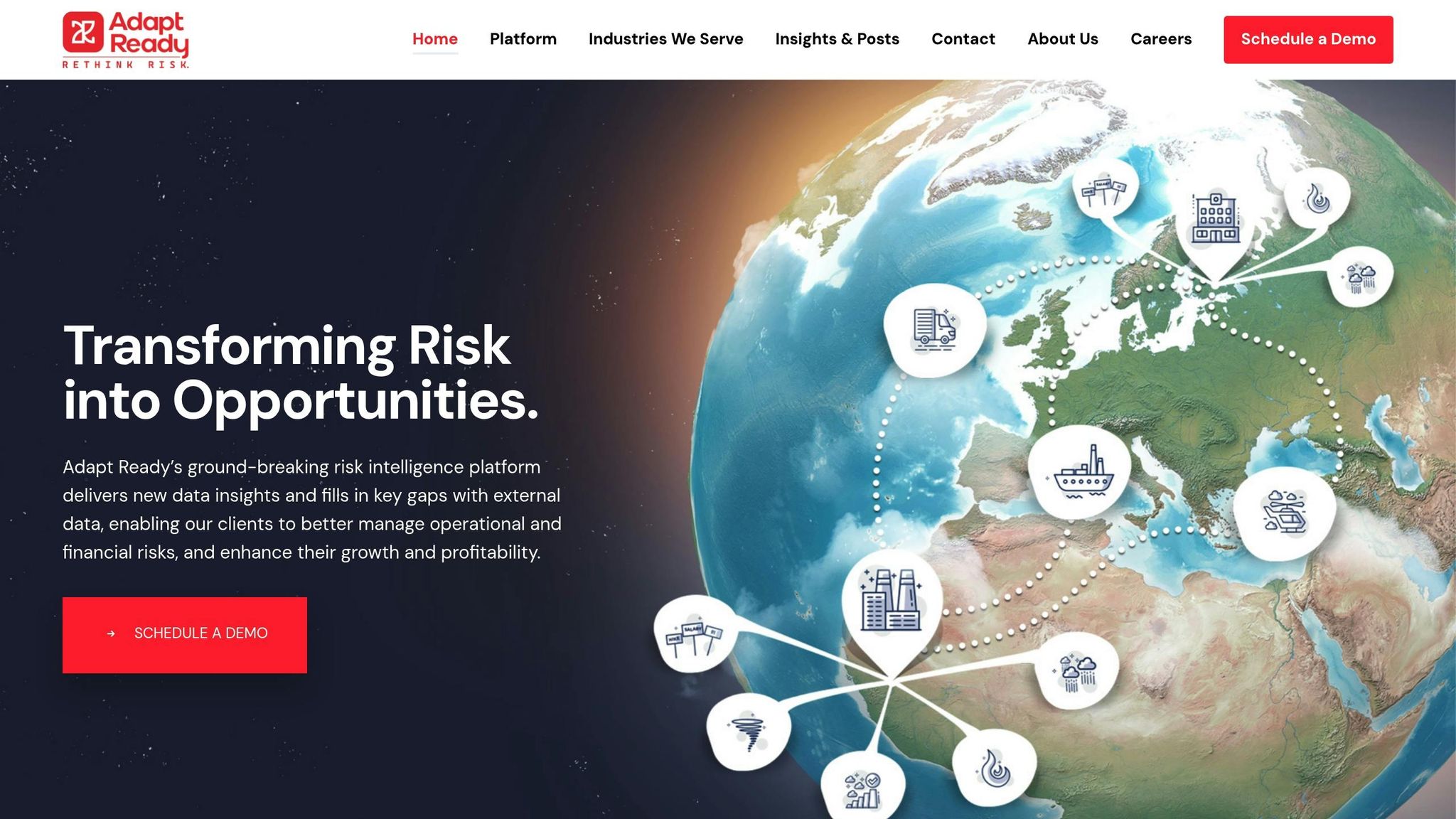
Since 2016, Adapt Ready has been turning external data into actionable insights, helping global industries tackle risks with AI-powered analytics. By combining big data, artificial intelligence, and machine learning, the company pulls information from a variety of sources to provide real-time intelligence. This allows organizations to navigate the complexities of environmental risks more effectively.
Environmental Risk Reporting Capabilities
Adapt Ready processes and refines both proprietary and public data to generate precise environmental risk insights. The platform specializes in climate risk assessment and geospatial analytics, which are essential for accurate risk reporting. By diving into complex data sets, it pinpoints and quantifies interconnected risks across global operations. Whether it's mapping exposures at a single location or across an entire portfolio, the platform delivers tailored insights that businesses can act on.
Industry-Specific Applications
Adapt Ready supports industries dealing with business interruptions, property risks, and specialized challenges. Its analysis spans diverse exposures, from offshore energy risks to professional liability, enabling businesses to understand risks both globally and locally. For insurance carriers, the platform offers a clearer picture of risk exposures, helping them write more profitable policies and improve claims and underwriting processes. Financial institutions and investors also benefit, as the platform bridges structured and unstructured data to enhance analysis for portfolios and individual investments.
Supply chain risks, which account for 90% of greenhouse gas emissions, are a key focus. Accurate context and detailed assessments are critical in addressing these challenges.
"The lack of data with context is the biggest hurdle in understanding supply chain risk." – Sandeep Chandur, Adapt Ready CTO
This highlights the importance of precise risk assessments for environmental compliance and strategic decision-making.
Key Features for Analytics and Compliance
Adapt Ready provides flexibility through its dedicated portal and APIs, making it easier for organizations to access and integrate environmental risk data. The platform identifies companies and assets at risk from business interruptions, supply chain disruptions, property issues, and security concerns. Its machine learning capabilities address gaps in climate adaptation and risk measurement. Since effective climate modeling depends on strong data, Adapt Ready plays a critical role in bridging those gaps.
Relevance for U.S.-Based Industries
For U.S. organizations, Adapt Ready offers tools like the US Tariff Dashboard, which helps address region-specific regulatory and economic factors affecting environmental risk. This localized approach strengthens the platform’s ability to connect global risk metrics with U.S. regulatory requirements. For instance, its real-time analysis during the October 2024 Hurricane Milton report enabled U.S. businesses to quickly assess environmental risks and their potential impacts.
Reflecting on these challenges, Shruthi Rao, Adapt Ready's CEO and Co-Founder, noted:
"Our report clearly shows that greater global connectivity is leading to further reaching and more complex supply chains. In turn, this is leading to increased complexity when it comes to understanding and managing the potential risks they are exposed to. In an era of heightened geo-political uncertainty and evolving natural catastrophe risk due to climate change, insurers, brokers and corporate risk managers are facing a challenge to oversee and navigate this."
For U.S. companies managing intricate global supply chains, the ability to analyze interconnected risks is invaluable. Even minor changes, like a $0.01 per pound fluctuation in cotton prices, can lead to millions in additional raw material costs annually.
sbb-itb-2e26d5a
5. EarthScan
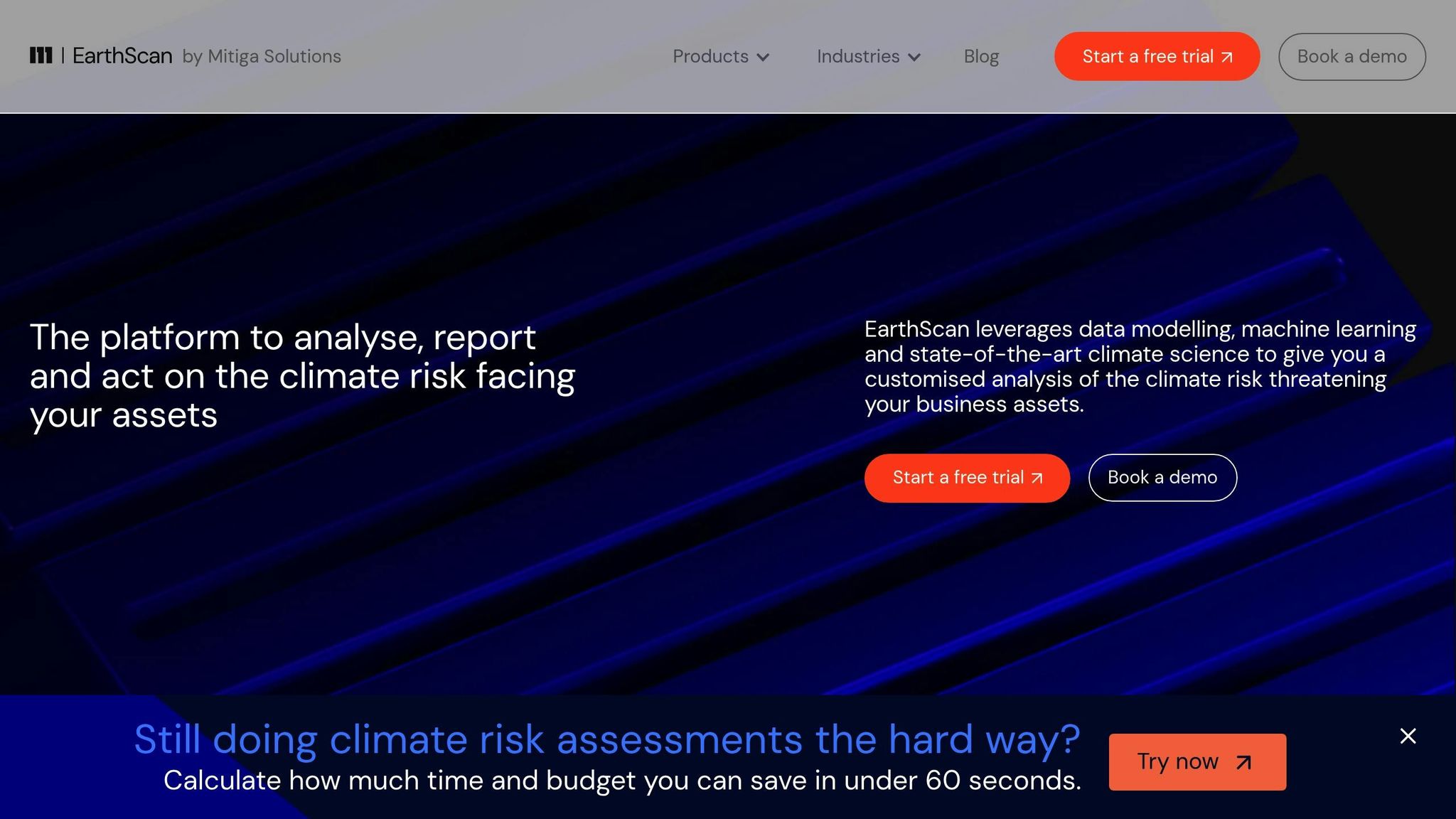
EarthScan is a climate risk analytics platform that turns complex environmental data into practical insights. Using Earth Science AI, it provides highly detailed risk assessments with a resolution of 90 meters. The platform has already analyzed $500 billion worth of assets and delivers results in under a minute for every 100 assets analyzed. This speed and accuracy make it a go-to tool for reporting and compliance needs.
Environmental Risk Reporting Capabilities
EarthScan is designed to meet strict regulatory disclosure requirements, including frameworks like CSRD, TCFD/ISSB, and the EU taxonomy. It offers global climate hazard probabilities using standardized scenarios in 5-year increments, spanning from 1970 to 2100. The platform evaluates seven key climate risk categories - heat stress, drought, wildfire, flooding, extreme wind, and precipitation. Users can generate customized reports featuring charts, explanatory text, and citations tailored to their needs.
In 2023, a Fortune 100 automobile manufacturer partnered with EarthScan to evaluate physical climate risks for their manufacturing and support locations. This included assessments for new sites and covered risks such as flooding, heat stress, wildfire, precipitation, and drought across three different climate scenarios.
"In partnership with Earthscan, we have performed physical climate risk assessments for our manufacturing and support locations, including for any new manufacturing sites. Using Earthscan we assessed physical risks related to flooding, heat stress, wildfire, precipitation and drought across three scenarios." – Fortune 100 Automobile Manufacturer
Industry-Specific Applications
EarthScan adapts its analytics to suit various industries. Asset management firms use it to evaluate risks at both asset and portfolio levels while ensuring compliance with regulations. Climate and risk consultants rely on the platform to assess and disclose climate risks for their clients' portfolios. In the real estate and hospitality sectors, EarthScan supports due diligence for existing and new properties, as well as supply chain risk analysis and strategic location planning.
A notable example is Arjun Infrastructure Partners, which manages $6 billion in assets. They use EarthScan to incorporate climate risk assessments into pre-transaction due diligence, comply with regulatory disclosures, and address climate-related challenges for their managed assets.
"With EarthScan, we are able to harness climate science from a range of leading sources across multiple climate scenarios to derive insights for action. We can challenge management teams on topics like operability and expenditure risk in the event of increasing climate volatility." – Rhyadd Keaney-Watkins, Head of ESG at Arjun Infrastructure Partners
Key Features for Analytics and Compliance
EarthScan provides on-demand climate risk analysis, focusing on hazards like flooding, drought, and extreme temperatures. By utilizing top-tier climate datasets and modeling various scenarios, it offers detailed insights at both asset and portfolio levels, including Climate Value at Risk calculations. Users can upload asset data through CSV files to quickly access risk insights and download reports aligned with CSRD and ISSB standards for regulatory purposes. The platform also automates the creation of report narratives and calculates financial impacts.
Relevance for U.S.-Based Industries
EarthScan's insights are particularly valuable for U.S. industries grappling with increasing climate challenges. With 79% of businesses globally affected by extreme weather, EarthScan delivers precise, location-specific data for assets across the United States. Its extensive North American coverage and mapped asset database help businesses build resilience, safeguard profits, and make informed decisions about property investments or retrofitting assets to withstand climate risks. Additionally, it supports local councils and governments in integrating climate risk considerations into urban development plans. For added convenience, EarthScan is available on Microsoft AppSource, ensuring smooth integration with existing workflows.
6. RiskPal
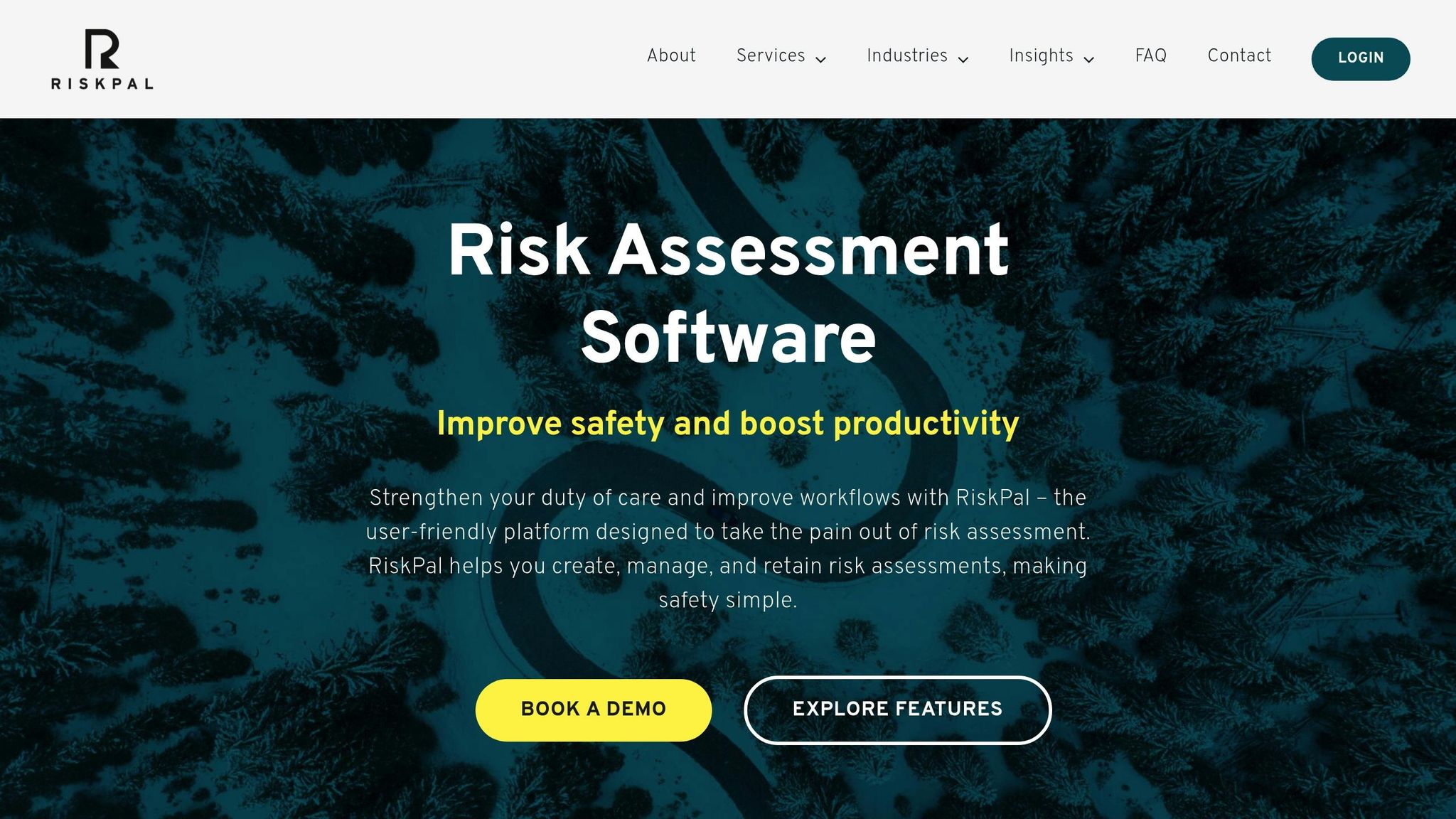
As businesses increasingly seek precise tools for managing environmental risks, RiskPal steps in to simplify the process while ensuring compliance. By digitizing traditional workflows, RiskPal makes risk assessments more efficient and user-friendly. With ISO 27001 certification - widely regarded as the gold standard in information security - the platform encrypts all data, whether stored or in transit, safeguarding sensitive information.
Environmental Risk Reporting Capabilities
RiskPal's analytics tools create detailed reports directly from a centralized dashboard, offering insights into risk activities, assessment patterns, and emerging trends. It also maintains a comprehensive audit log, recording every change and action taken within risk assessments. This feature is especially useful for organizations needing to demonstrate their risk management processes to auditors or regulatory bodies.
The platform includes a risk assessment register, which serves as a digital archive for storing, searching, and retrieving past assessments. Users can instantly access historical data, tracking how environmental risks have evolved over time. Additionally, its integrated approvals and notifications enhance collaboration, speeding up the risk assessment process while keeping all communications and edits transparent and easy to review.
Industry-Specific Applications
RiskPal is designed to adapt to various industries by offering configurable templates. These templates allow users to create risk assessments tailored to their specific needs, with customizable field names that align with their unique processes and terminology. The platform also includes an activity risk guidance library, a searchable database of health, safety, and travel advice that can be incorporated into assessments.
Educational institutions have found RiskPal particularly effective. For example, the National Film and Television School (NFTS) implemented the platform to enhance their risk management. Bex Hopkins, Head of Production Management at NFTS, noted the immediate benefits:
"RiskPal has given us a digital risk assessment solution that is intuitive, efficient and easy to use. The students have quickly embraced it in their work and collaboration between team members has improved." – Bex Hopkins, Head of Production Management, The National Film and Television School (NFTS)
Similarly, the Armed Conflict Location & Event Data Project (ACLED) relies on RiskPal for its operations. Michelle Stone, Associate Operations Coordinator at ACLED, highlighted the platform's dependability:
"RiskPal is our trusted risk management partner." – Michelle Stone, Associate Operations Coordinator, The Armed Conflict Location & Event Data Project (ACLED)
These examples showcase the platform’s flexibility and usefulness across different industries.
Key Features for Analytics and Compliance
In addition to its customizable templates, RiskPal offers powerful compliance tools. Its risk matrix helps organizations evaluate and prioritize risks by categorizing and quantifying residual risks after controls are applied.
The platform also provides country threat profiles, which offer summaries of local threat environments and recent incidents. Users can further enhance these profiles by adding internal intelligence, travel protocols, and past experiences. Another standout feature is the supplier database, a centralized resource where organizations can log and share details about trusted third-party service providers.
RiskPal encourages collaboration through its staff feedback feature, which captures insights from team members about destinations, suppliers, and lessons learned. Additionally, the emergency profiles tool ensures that critical information is readily available during crises, with GDPR-compliant procedures for consent, authorization, and notifications.
Relevance for U.S.-Based Industries
For U.S. organizations, RiskPal offers secure integration options like Multi-Factor Authentication (MFA) and Single Sign-On (SSO), providing both convenience and robust security against unauthorized access. The platform is fully GDPR-compliant, ensuring high standards of data privacy and security.
Media organizations have particularly benefited from RiskPal’s capabilities. ITV News, for instance, uses the platform to provide teams with proper guidance before undertaking risky assignments. Delilah Jeary, Series Producer at ITV News, praised its efficiency:
"RiskPal ensures teams have clear, best-practice guidance before any assignment. So they behave more safely and at the same time there is little bureaucratic headache." – Delilah Jeary, Series Producer, ITV News
RiskPal’s ability to integrate seamlessly with existing workflows makes it especially appealing to U.S. companies. It enables organizations to create tailored risk assessments while maintaining consistency across operations. This is essential for industries facing evolving environmental and safety challenges, where secure and efficient risk management is more important than ever.
Platform Comparison Table
Here's a streamlined comparison of the four platforms we covered, highlighting their main features, industry focus, and pricing models. Each platform brings a distinct set of strengths tailored to meet specific organizational and industry demands.
| Platform | Key Features | Supported Industries | Strengths | Pricing |
|---|---|---|---|---|
| Workiva | Connected data management, automated reporting, SOX compliance, real-time collaboration | Enterprise companies (1,001+ employees), financial services, manufacturing | Strong compliance tools and enterprise-grade solutions | Custom pricing (not publicly disclosed) |
| Coupa | Sustainability ratings, actionable insights, ESG communications | Consumer goods, food and beverage, financial services | Focused ESG tools with supply chain management emphasis | Custom pricing based on requirements |
| Manifest Climate | Climate risk tracker; risk identification, assessment, and prioritization | Finance, real estate, insurance | Scalable, industry-specific climate risk modeling | Custom pricing (not publicly disclosed) |
| Adapt Ready | Climate risk assessment; geospatial analytics; business interruption insights | All industries | Advanced geospatial analytics and business impact insights | Custom pricing based on scope |
Each platform offers custom pricing, tailored to the specific needs and scale of your organization.
Industry Focus Overview
The platforms cater to distinct industries based on their strengths. Workiva is ideal for large enterprises needing robust compliance tools, while Coupa specializes in sustainability and supply chain management for consumer-facing industries. Manifest Climate stands out in financial and insurance sectors with its tailored climate risk modeling. Meanwhile, Adapt Ready provides versatile solutions for a wide range of industries, excelling in geospatial and business impact analytics.
Choosing the Right Platform
When deciding between these platforms, it’s crucial to weigh factors like data quality, ease of integration, technological depth, and customer support. Large enterprises often lean toward Workiva for its compliance expertise, while companies with intricate supply chains may prefer Coupa for sustainability management. For those in finance or insurance, Manifest Climate offers specialized tools for climate risk analysis, whereas Adapt Ready shines with its broad applicability and geospatial insights.
This breakdown should help guide your decision-making process for selecting the best platform to address your environmental risk analytics needs.
Conclusion
Environmental risk analytics platforms have become a critical tool for U.S. businesses as they navigate increasing regulatory pressures and mounting climate risks. With 86% of companies now releasing sustainability reports and 82% identifying regulatory transition risks that could affect their operations, the demand for advanced analytics tools is more pressing than ever.
The platforms highlighted - Workiva, Coupa, Manifest Climate, and Adapt Ready - each cater to specific industry needs, helping businesses tackle the complexities of environmental compliance. This level of specialization is particularly crucial when you consider that 66% of major global companies have at least one asset at high risk under projected climate change scenarios by 2050.
"Properly monitoring, managing, and reporting progress against targets and commitments requires accurate, timely, and reliable data on the performance of a company's principal assets and operations on these environmental dimensions. And so as with financial data, this data on corporate environmental performance will increasingly be communicated to stakeholders and the market directly by companies and through data aggregators."
- Robert Herz, Member of the Board of Directors at Morgan Stanley and Former Chair of the Financial Accounting Standards Board
Choosing the right platform means aligning it with your specific compliance requirements, industry demands, and sustainability goals. Companies that integrate strong risk management strategies often reap significant benefits. For example, businesses with robust ESG practices achieved 2.6 times higher shareholder returns compared to average performers between 2013 and 2020. Additionally, ethical supply chain practices can increase revenue by up to 20% and cut costs by as much as 16%.
Investing in environmental risk analytics doesn’t just ensure regulatory compliance - it empowers companies to proactively identify and address risks before they escalate. With environmental factors accounting for 23% of global deaths and air pollution alone causing 7 million deaths annually, the urgency for effective environmental management is undeniable.
For U.S. businesses, the real challenge lies in selecting platforms that not only meet today’s regulatory demands but also offer the scalability and real-time insights needed to stay ahead of future environmental challenges. The right platform can transform into a strategic asset, supporting compliance while bolstering long-term business resilience - a recurring theme throughout this discussion.
FAQs
How can I choose the best environmental risk analytics platform for my industry and needs?
When selecting an environmental risk analytics platform for your industry, it's essential to zero in on a few critical features. Look for tools that offer robust data management, flexible reporting options, and real-time data processing. These functions are the backbone of accurate risk evaluation and staying compliant with regulations.
Beyond the technical capabilities, think about how well the platform fits your organization’s needs. Does it scale as your business grows? Is the interface intuitive enough for your team to use without a steep learning curve? And don’t overlook the importance of reliable customer support - a responsive support team can make a world of difference when challenges arise. Focusing on these elements will guide you toward a platform that’s well-suited to tackle the unique environmental challenges of your industry.
What features should an environmental risk analytics platform have to ensure compliance with U.S. and global regulations?
To stay compliant with U.S. and international regulations, an effective environmental risk analytics platform needs to include automated reporting, real-time monitoring, and document management tools. These features are essential for keeping up with regulatory changes, maintaining accurate records, and meeting compliance requirements proactively.
On top of that, platforms should provide customizable alerts and checklists to handle the constantly shifting standards at federal, state, and local levels. This is particularly critical in the U.S., where overlapping regulations can make the process more challenging. With these tools in place, businesses can reduce legal risks and respond swiftly to any regulatory updates.
How can companies use environmental risk analytics platforms to strengthen ESG strategies and boost shareholder value?
Companies are turning to environmental risk analytics platforms to better identify and manage risks related to the environment. These tools help ensure compliance with regulations while strengthening a company's ESG (Environmental, Social, and Governance) strategies. By offering actionable insights, they make it easier for businesses to create transparent ESG reports, which can build trust with both investors and stakeholders.
Incorporating ESG data into decision-making can lead to lower operational costs, reduced risks, and greater appeal to investors who prioritize sustainability. Beyond these benefits, it can also boost long-term financial performance and demonstrate a commitment to responsible, forward-thinking practices - ultimately increasing shareholder value.



